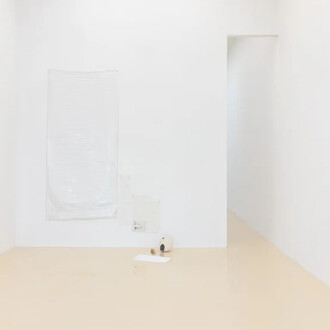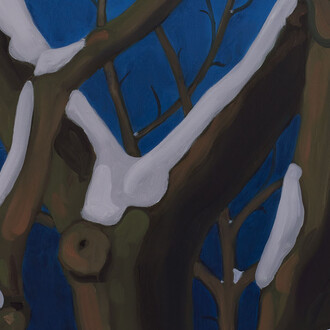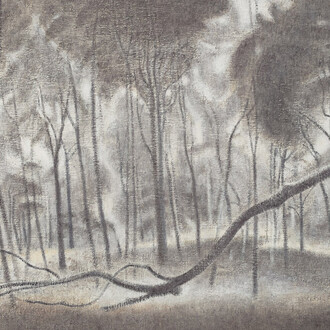Gaga & Reena Spaulings, LA, present an installation of new paintings and kinetic sculptures by Naoki Sutter-Shudo. End of Thinking Capacity stages a sort of farce or concept of a possible exhibition, with a gang of seven humanoid “critics” performing the work of aesthetic judgment before twelve freshly painted works on canvas.
Mechanical metronomes seem to bring the sculpture-critics to life: the measured, clockwork ticking of the critical faculty, the wagging finger of judgment. Their heads are made by sculpting epoxy clay over doll heads and Halloween skulls, then painted with glossy enamel colors. Sponges, bubble wrap, and liquor bottles flesh out the bodies of these figures, which stand upon pedestals of boxed art and lifestyle magazines. The paintings, meanwhile, vary widely as far as genre and visual content. Imagery taken from book covers and other printed matter betray the artist’s wayward bibliophilic proclivities.
There are also paintings of paintings: a scaled-up copy of a composition by Sutter-Shudo’s wife Alexandra Noel, but with an added paintbrush and its shadow; also a portrait of the French revolutionary Saint-Just taken from the cover of a book by Tatsuhiko Shibusawa. Other works depict the Hawaiian flag, a cigarette lighter printed with a slogan that echoes the exhibition’s title, and an outer space scene with glowing Japanese characters (= “stranger” or “foreigner”) and zooming crackers. A cartoonish marine scene is based on an eco-friendly campaign against littering which the artist saw printed on a French cigarette pack.
Another canvas references Marine Le Pen’s mother Pierrette’s scandalous appearance, in 1987, as a slutty French maid in the pages of Playboy magazine. There are also paintings depicting cropped fragments of Louis C.K.’s illuminated stage set for his Netflix comeback special Sorry. Etc. End of Thinking Capacity pantomimes the situation of aesthetic judgment, with paintings that summon their critics and sculptures that seem to do the work of viewing and thinking. If actual human viewers feel sidelined by Sutter-Shudo’s auto-critical installation, which pretends to consume and complete itself, we can now be as delinquent and free-ranging as the artist. Gravitas is levitated and the critically unemployed viewer is set adrift along with the works, which double as props and performers. Sutter-Shudo locates joy in this experience of release, where art discovers the freedom to play itself: the exhibition and its double.













